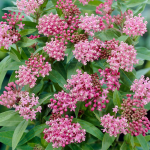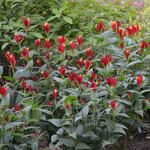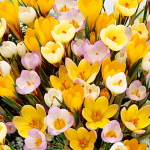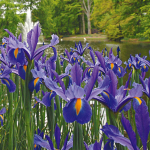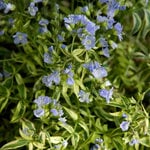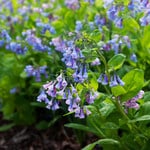Product Details
Plant Crocus sativus bulbs and grow your own saffron to use in cooking. We rarely think of bulbs as edible, but this showy fall-blooming Crocus is the source of saffron, the quintessential seasoning for paella and other dishes from the Mediterranean and Asia. Each lilac-purple flower produces three red stigmas, which have been used for flavoring and coloring food since Roman times. For more information, read our instructions on harvesting saffron.
Perhaps because the sun is so low in the sky after the autumn equinox, the blooms of fall Crocus positively glow in the landscape. They appear between September and January (depending on your climate) on stems 3–6″ tall and have the same refined goblet-shaped flowers of their spring cousins.
We ship fall Crocus in September. The bulbs must be planted right away so they may go about the business of rooting. Fall Crocus grow best in a sunny, protected site.
For more information on Crocus care, click Growing Guide.
Shipping
HOW PLANTS ARE SHIPPED
The size of the plants we ship has been selected to reduce the shock of transplanting. For some, this means a large, bareroot crown. Others cannot travel bareroot or transplant best if grown in containers. We ship these perennials and annuals in 1 pint pots, except as noted. We must point out that many perennials will not bloom the first year after planting, but will the following year, amply rewarding your patience. We ship bulbs as dormant, bare bulbs, sometimes with some wood shavings or moss. Shrubs, Roses, vines, and other woody plants may be shipped bareroot or in pots. The size of the pot is noted in the quick facts for each item.
WHEN WE SHIP
We ship our bulbs and plants at the right time for planting in your area, except as noted, with orders dispatched on a first-come, first-served basis by climate zone. We also ship a wide range of containers and planters, tools, supplies, fertilizers, garden wear, garden decor items, as well as indoor decorations like wreaths and dried bouquets when available. Estimated dates for shipping are indicated in the green Shipping Details box for each item. Please supply a street address for delivery. Kindly contact us with two weeks notice, if you'll be away at the expected time of delivery.
OUR GUARANTEE
We guarantee to ship plants that are in prime condition for growing. If your order is damaged or fails to meet your expectations, we will cheerfully replace or refund it. Please contact our Customer Service Department at 1-800-503-9624 or email us at [email protected]. Please include your order number or customer number when contacting us.
Reviews
Average Customer Rating:
 (21 Reviews)
Write a Review
(21 Reviews)
Write a Review
Sort by:
Nice Bulbs, Blooms First Year 
A viewer from Arizona
The bulbs came nicely packed, looked healthy, and I got them into long rectangle pots a couple days after arrival in late Oct 2020. Out of 18 planted (any that didn't fit in the pots went to my parents), all came up, only one is struggling and stunted. 4-5 plants bloomed this year about two weeks after planting, which was a nice surprise since I figured I wouldn't see any flowers the first year. Now in mid-Jan, I have very long grassy leaves left, just waiting for that to die off and dormancy to start and see how they come up in the fall this year.
Very happy with this set of bulbs, would definitely recommend them.
17 of 17 people found this review helpful. Do you? yes no Certified buyer
Healthy, heavy bulbs, bloomed within weeks 
A viewer from GA
Blooms first of November! 
A viewer from Georgia
14 of 14 people found this review helpful. Do you? yes no Certified buyer
Growing guide
Saffron is a delicious and colorful seasoning that is used in breads, desserts, and main dishes in many parts of the world, from England to India, from the Middle East to Scandinavia, and all around the Mediterranean. Without it, an Indian curry or a Spanish paella just wouldn't be the same.
The bright red-orange threads you get when you buy saffron are actually the stigmas, or female portion, of the Saffron Crocus flowers. It takes hundreds of flowers to produce a commercially useful amount, which explains why saffron is so expensive. For the home gardener, however, two dozen Saffron Crocus will supply enough of the precious spice for a few memorable dishes. With each successive year, the corms (which look like bulbs) will multiply, the size of the planting will increase, and you'll be able to harvest more of the spicy stigmas. After 4 to 6 years, you should divide and replant the corms (do it right after the foliage has faded). Division prevents overcrowding, which can lead to a decrease in flowering.
Planting Saffron Crocus Corms: In areas where Saffron Crocus are reliably hardy—USDA Zone 6 through 8 in the South, 6 through 9 in the West—you should plant the corms as soon as you receive them. Saffron Crocus do best in full sun and well-drained soil that is moderately rich in organic matter. Ideally, the site should be relatively dry in summer, when the corms are dormant.
Plant the corms 4in deep and 4in apart. If gophers, mice, or voles are a problem in your garden, plant the corms in containers or line the bed with hardware cloth or a similar wire mesh. Flowers generally come up 6-8 weeks after planting, although occasionally they wait until the 2nd fall to appear. Bloom lasts about 3 weeks. The grass-like leaves may emerge either with the flowers or soon after they appear. Sometimes they wait until the following spring. In either case, the leaves persist for 8-12 weeks, then wither and vanish, leaving no trace of the corms below until the flowers appear again in fall. It's not a bad idea to mark the area where you've planted your corms, so you don't inadvertently dig them up while planting something else.
Overwintering Corms in Cold Climates: Saffron Crocus can be grown in areas with colder winters than Zone 6, but the corms must be lifted and brought indoors for the winter. After the first few frosts, but before the ground has frozen solid, carefully dig out the corms, place them in a wooden crate or plastic tub, and completely cover with dry peat moss or sand. Store in a cool (40-50°F), dry place, such as a basement. Plant them out again in the spring after all danger of frost has passed, but don't water until you see new growth in early autumn.
Another way of growing Saffron Crocus in cold-winter areas is to plant the corms 2 in. deep in clay or plastic pots filled with a well-drained soil mix, and then set the pots directly in the ground, with the rims about 2 inches below the soil surface, so the pots don't show. After the plants die back in the fall, move the pots into the basement and store them dry for the winter. Set the pots back out the following spring. Again, marking the pots' location so you don't accidentally dig into them is probably a good idea.
Harvesting and Using Saffron: Three stigmas are borne in the center of each purple, cup-shaped bloom. The best time to harvest the stigmas is mid-morning on a sunny day when the flowers have fully opened and are still fresh. Carefully pluck the stigmas from the flowers with your fingers, then dry them in a warm place to preserve them for cooking. Store in a closed container. To use saffron, steep the threads in hot liquid (water, broth, or milk, depending on the recipe) for about 20 minutes. Add both the threads and the steeping liquid early in the cooking or baking process, and the threads will continue to release their color and flavor.

